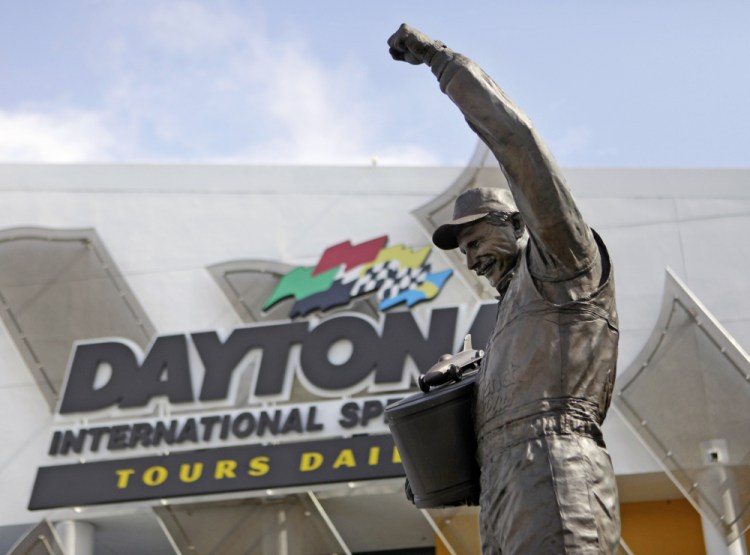I was certainly not a fan of Dale Earnhardt.
That fact was cemented at Bristol Motor Speedway in the summer of 1999, when “The Intimidator” wrecked Terry Labonte for the win on the final lap before famously smirking while uttering one of his most famous post-race quips.
“I didn’t mean to wreck him,” Earnhardt said then. “I just wanted to rattle his cage a bit.”
Both sides rallied to their respective causes in the aftermath of that race, and the sides were clear. It wasn’t Earnhardt versus Labonte, it was Earnhardt versus the stock car racing world. Both sides were fervent, righteous and whipped into a frenzy of screeching tires and burning gasoline.
Less than two years later, Earnhardt was gone.

Killed in a crash on the final lap of the 2001 Daytona 500, Dale Earnhardt’s NASCAR legacy lives on two decades later.
Earnhardt was, himself alone, NASCAR’s holy trinity.
He was a seven-time series champion, a feat no other driver has topped (Richard Petty and Jimmie Johnson each have seven Cup Series titles), with 76 career victories.
Earnhardt was the man in the black hat (perfectly embodied by his jet black No. 3 Chevrolet) who provided the antihero that divided a fan base and created interest each and every weekend — whether the event was a crown jewel at Daytona International Speedway or Indianapolis Motor Speedway, or long lost and forgotten races at Texas World Speedway or Ontario Motor Speedway.
Less talked about, but perhaps the most significant piece of Dale Earnhardt’s career, was how he conducted NASCAR’s marketing boom in the late 1990s. While he and Jeff Gordon battled relentlessly as bitter rivals on the race track, away from it the two were business partners pumping out t-shirts and paraphernalia that produced cash flow — from both fanbases — by capitalizing financially on that rivalry.
Earnhardt became the voice the sport always turned to for clarity and direction, his reasoning respected by fellow competitors and NASCAR brass alike.
Entering the stage as a mainstream American sport in 2001, NASCAR transitioned into its biggest television deal in the sport’s history with the Daytona 500 that claimed Earnhardt’s life. FOX took coverage of the first half of the NASCAR season for the first time that year, and the man who had helped build the empire was gone as soon as it started.
Earnhardt’s 1998 Daytona 500 win was one of the most popular victories in the sport’s history, yet The Intimidator never got to see the multi-car team he owned — Dale Earnhardt, Inc. — win its first superspeedway race when Michael Waltrip drove under the checkered flag that afternoon.
Earnhardt’s loss has been felt. Remarkably, it’s still felt in some respects 20 years later.
Naturally, in the immediate aftermath, fans of Earnhardt gravitated their allegiances toward Dale Earnhardt Jr., who drove for DEI through the 2007 season before the operation shuttered its doors after 2008, or to Kevin Harvick, who inherited the Richard Childress-owned ride Earnhardt had made so famous.
The real loss came for those who had nobody to openly root against any longer. Drivers like Gordon, Harvick and Tony Stewart — and later Jimmie Johnson and Kyle Busch — had their fair shares of detractors, but even the ire which fans directed at them paled in comparison to the vitriol Earnhardt could summon with just a simple wink and a smirk.
Losing Earnhardt when NASCAR did would be akin to the NBA losing Michael Jordan prior to the start of the 1998 season, the year he won his sixth title with the Chicago Bulls, or Tom Brady suddenly passing away on the eve of the Super Bowl earlier this month.
Morbid thoughts, certainly, but it’s exactly what NASCAR faced with Earnhardt’s loss. Five days after his fatal accident, NASCAR was at a race track in Rockingham, North Carolina, a collective blank stare emanating in both directions — from those inside the garage and from those looking on via their television sets at home, none of them quite sure how it all would proceed without Earnhardt himself to guide them.
How would the NBA and NFL machines recover from such hallowed superstars of their respective sports not just retiring, but disappearing entirely, from the game their names have become synonymous with? How would they maneuver with just days — and not a months-long offseason — to regroup before the product is expected to crank along again?
Stock car racing moved on. NASCAR always moves on, forges forward, streaks toward a finish line that is forever inching further and further into the future.
In the 63rd Daytona 500 on Sunday, more history will be on the line. Denny Hamlin will attempt to become the first driver ever to win the race three times in a row. Bubba Wallace will attempt to become the first African-American driver to win the Great American Race. Ryan Newman will attempt to gain redemption after a brutal crash while leading just a couple of hundred yards from victory in 2020. Busch, Harvick, and Joey Logano will try and cement their legacies as among NASCAR’s best ever at Daytona.
We as a world will attempt to recover from political divide, a global pandemic and a deeply wounded workforce as the 2021 season begins.
Dale Earnhardt was the everyman on a tractor who commanded respect in boardrooms. He won races, he rattled cages and he was the face of American motorsports for the better part of two decades.
NASCAR, and the world at large, hasn’t been the same since this weekend 20 years ago.
Comments are not available on this story.
Send questions/comments to the editors.



